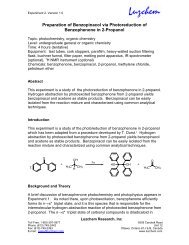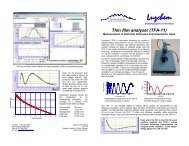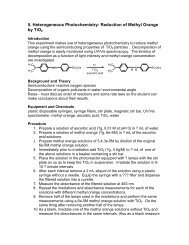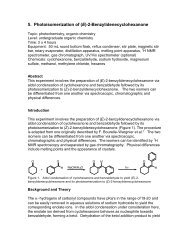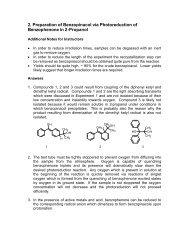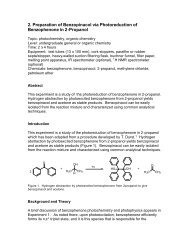1. Photoreduction of Benzophenone in 2-Propanol
1. Photoreduction of Benzophenone in 2-Propanol
1. Photoreduction of Benzophenone in 2-Propanol
You also want an ePaper? Increase the reach of your titles
YUMPU automatically turns print PDFs into web optimized ePapers that Google loves.
<strong>1.</strong> <strong>Photoreduction</strong> <strong>of</strong> <strong>Benzophenone</strong> <strong>in</strong> 2-<strong>Propanol</strong><br />
Topic: photochemistry, photophysics, k<strong>in</strong>etics, physical-organic chemistry<br />
Level: undergraduate physical chemistry<br />
Time: 2 x 2 hours (separated by ~24 hours)<br />
Equipment: volumetric flasks, quartz cells, rubber septa, degass<strong>in</strong>g needles,<br />
nitrogen or argon tank, UV/Vis spectrometer<br />
Chemicals: benzophenone, 2-propanol, naphthalene<br />
Abstract<br />
This experiment is a k<strong>in</strong>etic study <strong>of</strong> the photoreduction <strong>of</strong> benzophenone <strong>in</strong> 2-<br />
propanol. Hydrogen abstraction by photoexcited benzophenone from 2-propanol<br />
yields benzop<strong>in</strong>acol and acetone as stable products. In the presence <strong>of</strong><br />
naphthalene, energy transfer from photoexcited benzophenone to naphthalene<br />
competes with hydrogen abstraction. The rate constant for the hydrogen<br />
abstraction reaction can be determ<strong>in</strong>ed by vary<strong>in</strong>g the naphthalene concentration<br />
and mak<strong>in</strong>g use <strong>of</strong> the Stern-Volmer k<strong>in</strong>etic relationship.<br />
Introduction<br />
This experiment is a k<strong>in</strong>etic study <strong>of</strong> the photoreduction <strong>of</strong> benzophenone <strong>in</strong> 2-<br />
propanol which has been adapted from experiments described by P.Natarajan 1<br />
as well as M.S. Churio and M. A. Grela. 2 Hydrogen abstraction by photoexcited<br />
benzophenone from 2-propanol yields benzop<strong>in</strong>acol and acetone as stable<br />
products. As the reaction proceeds, benzophenone is depleted; its<br />
disappearance can be monitored with a UV/Vis spectrometer. In the presence <strong>of</strong><br />
naphthalene, the rate <strong>of</strong> benzophenone depletion is reduced because energy<br />
transfer to naphthalene competes with hydrogen abstraction from 2-propanol<br />
(Figure 1). The rate constant for the hydrogen abstraction reaction can be<br />
determ<strong>in</strong>ed us<strong>in</strong>g the Stern-Volmer k<strong>in</strong>etic relationship.<br />
3 *<br />
O<br />
OH<br />
H 3 C CH 3<br />
H<br />
OH<br />
H 3 C CH 3<br />
+<br />
OH<br />
O<br />
+<br />
3 *<br />
Figure <strong>1.</strong> The competition between hydrogen abstraction from 2-propanol and energy transfer to<br />
naphthalene.
Background and Theory<br />
Absorption <strong>of</strong> a photon by a molecule excites it from its ground state (S 0 ) to an<br />
electronically excited s<strong>in</strong>glet state. This transition is the result <strong>of</strong> an electron<br />
jump from a low energy orbital <strong>in</strong>to a higher energy orbital with conservation <strong>of</strong><br />
electron sp<strong>in</strong> angular momentum. The s<strong>in</strong>glet excited state (S n ) which is <strong>in</strong>itially<br />
populated is not necessarily the lowest s<strong>in</strong>glet excited state (S 1 ). S 1 is populated<br />
after vibrational relaxation (VR) and <strong>in</strong>ternal conversion (IC) <strong>of</strong> the first-formed<br />
S n . The processes which lead to the formation <strong>of</strong> the lowest vibrational level <strong>of</strong><br />
S 1 occur with unity efficiency for most molecules. Possible deactivation<br />
pathways from S 1 are chemical reaction, fluorescence, IC back to S 0 and<br />
<strong>in</strong>tersystem cross<strong>in</strong>g (ISC) to a triplet excited state (T n ), which may be the lowest<br />
triplet excited state (T 1 ). ISC is an isoelectronic transition between states <strong>of</strong><br />
differ<strong>in</strong>g multiplicities which <strong>in</strong>volves flipp<strong>in</strong>g an electron's sp<strong>in</strong>. Possible<br />
deactivation pathways from T 1 are chemical reaction, phosphorescence and ISC<br />
back to S 0 . These processes are represented schematically <strong>in</strong> a Jablonski<br />
diagram (Figure 2).<br />
VR<br />
S n<br />
S 1<br />
T 1<br />
IC<br />
VR<br />
T n<br />
energy<br />
IC<br />
ISC<br />
ISC<br />
absorption<br />
fluorescence<br />
VR<br />
phosphorescence<br />
S 0<br />
Figure 2. A Jablonski diagram.<br />
A quantum yield, Φ, is a measure <strong>of</strong> the efficiency <strong>of</strong> a photochemical process,<br />
and is def<strong>in</strong>ed as the number <strong>of</strong> times that a process occurs per photon<br />
absorbed. Upon photoexcitation <strong>of</strong> benzophenone, ISC to its triplet state occurs<br />
with a rate constant <strong>of</strong> ~10 11 s -1 and a Φ = <strong>1.</strong> 3 Therefore, every time that a<br />
molecule <strong>of</strong> benzophenone absorbs a photon it reaches its T 1 . The T 1 <strong>of</strong><br />
benzophenone has an electronic structure which corresponds to an electron<br />
be<strong>in</strong>g promoted from a non-bond<strong>in</strong>g n orbital on oxygen to a π* orbital. This<br />
configuration is referred to as an n,π* triplet state. It is this species that is
esponsible for the <strong>in</strong>termolecular hydrogen abstraction reaction <strong>of</strong> photoexcited<br />
benzophenone from 2-propanol. The n,π* triplet state <strong>of</strong> carbonyl compounds is<br />
diradicaloid <strong>in</strong> nature, with their reactivity modeled by alkoxy radicals; hence,<br />
their tendency to participate <strong>in</strong> hydrogen abstraction reactions. 3 Any hydrogen<br />
abstraction process from T 1 which occurs must do so <strong>in</strong> competition with other<br />
modes <strong>of</strong> triplet decay which, <strong>in</strong> the case <strong>of</strong> benzophenone <strong>in</strong> 2-propanol, occur<br />
with a rate constant <strong>of</strong> ~1 x10 5 s -1 . 4<br />
While hydrogen abstraction reactions are relatively specific to the photochemistry<br />
<strong>of</strong> carbonyl conta<strong>in</strong><strong>in</strong>g compounds, a much more general process <strong>in</strong><br />
photochemistry is that <strong>of</strong> energy transfer. In the presence <strong>of</strong> certa<strong>in</strong> molecules<br />
(quenchers), which have an excited state energy lower than that <strong>of</strong> a molecule<br />
which has absorbed a photon (the sensitizer), energy transfer may occur to form<br />
an excited state <strong>of</strong> the quencher molecule, as shown <strong>in</strong> Figure 3.<br />
hν<br />
k<br />
Sensitizer + Quencher Sensitizer * + Quencher ET Sensitizer + Quencher*<br />
Figure 3. Energy transfer between a sensitizer and quencher.<br />
In this experiment, benzophenone acts as a sensitizer for the naphthalene triplet<br />
excited state; a corollary to this is that naphthalene acts as a quencher <strong>of</strong> the<br />
benzophenone triplet excited state. Under conditions <strong>in</strong> which energy transfer is<br />
very exothermic (>5 kcal/mol), as is the case for benzophenone and naphthalene<br />
which have triplet energies <strong>of</strong> 69 and 61 kcal/mol, 5 respectively, the rate constant<br />
for energy transfer occurs as quickly as diffusion <strong>of</strong> the two species <strong>in</strong> the solvent<br />
will allow. In 2-propanol, the rate constant for a diffusion-controlled process is<br />
2.7 x 10 9 M -1 s -1 . 2<br />
The reactions <strong>in</strong>volved <strong>in</strong> the photoreduction <strong>of</strong> benzophenone to benzop<strong>in</strong>acol <strong>in</strong><br />
the presence <strong>of</strong> a quencher appear <strong>in</strong> Figure 4. 6,7 A consideration <strong>of</strong> the<br />
competition between naphthalene quench<strong>in</strong>g and hydrogen abstraction from 2-<br />
propanol by triplet benzophenone <strong>in</strong> deaerated solutions via the Stern-Volmer<br />
k<strong>in</strong>etic analysis allows for the determ<strong>in</strong>ation <strong>of</strong> the rate constant for hydrogen<br />
abstraction from the follow<strong>in</strong>g expression, the derivation <strong>of</strong> which appears <strong>in</strong> the<br />
appendix:<br />
Φ o<br />
Φ = 1+<br />
k q [ Q]<br />
k h (CH 3 ) 2 CHOH<br />
[ ]<br />
This is a very powerful technique as it allows for determ<strong>in</strong>ation <strong>of</strong> k<strong>in</strong>etic<br />
parameters for processes which occur on the microsecond timescale without the<br />
benefit <strong>of</strong> time resolved techniques.
k abs<br />
φ 2 CO + hν 1 φ 2 CO *<br />
1 φ 2 CO * k isc 3 φ 2 CO *<br />
1 φ2 CO * k d<br />
φ 2 CO<br />
3 φ 2 CO * k d'<br />
φ 2 CO<br />
3 φ 2 CO * + (CH 3 ) 2 CHOH<br />
φ 2 CO + (CH 3 ) 2 COH<br />
φ 2 COH + φ 2 COH<br />
φ 2 CO * + naphthalene<br />
3 φ2 CO * + O 2<br />
k h<br />
k q<br />
k q'<br />
φ 2 COH + (CH 3 ) 2 COH<br />
φ 2 COH + (CH 3 ) 2 CO<br />
HO OH<br />
φ 2 C Cφ 2<br />
φ 2 CO + 3 naphthalene *<br />
φ 2 CO + 1 *<br />
O 2<br />
Figure 4. Reactions <strong>in</strong>volved <strong>in</strong> the photoreduction <strong>of</strong> benzophenone to benzop<strong>in</strong>acol <strong>in</strong> the<br />
presence <strong>of</strong> a quencher. φ 2 CO, 1 φ 2 CO* and 3 φ 2 CO* represent the benzophenone S 0 , S 1 and T 1<br />
states, respectively.<br />
Cross-coupl<strong>in</strong>g reactions between the diphenyl ketyl radical and the dimethyl<br />
ketyl radical to yield the products <strong>in</strong> Figure 5 also occur to a very small extent.<br />
These products are <strong>of</strong>ten referred to as light absorb<strong>in</strong>g transients because their<br />
extended conjugation makes them efficient absorbers <strong>of</strong> light and they are<br />
eventually removed from the reaction mixture via reaction with oxygen. The<br />
presence <strong>of</strong> these species <strong>in</strong>terferes with any attempts to measure the progress<br />
<strong>of</strong> the photoreduction <strong>of</strong> benzophenone by UV/Vis spectrometry.<br />
OH<br />
CH 3<br />
OH<br />
CH 3 OH<br />
OH H<br />
CH 3<br />
H<br />
CH 3<br />
Figure 5. The light absorb<strong>in</strong>g transients formed via cross-coupl<strong>in</strong>g radical reactions.<br />
Equipment and Chemicals<br />
volumetric flasks, quartz cells, rubber septa, degass<strong>in</strong>g needles, nitrogen or<br />
argon tank, UV/Vis spectrometer, benzophenone, 2-propanol, naphthalene
Procedure<br />
<strong>1.</strong> Prepare separate solutions <strong>of</strong> 25 mL <strong>of</strong> 25 mM benzophenone and 25 mM<br />
naphthalene <strong>in</strong> 2-propanol. Prepare 6 solutions for irradiation <strong>in</strong> cells which<br />
can be sealed with a septum by comb<strong>in</strong><strong>in</strong>g the aforementioned<br />
benzophenone and naphthalene solutions with 2-propanol <strong>in</strong> the amounts<br />
designated below:<br />
Component<br />
Volume (mL)<br />
benzophenone <strong>1.</strong>0 <strong>1.</strong>0 <strong>1.</strong>0 <strong>1.</strong>0 <strong>1.</strong>0 <strong>1.</strong>0<br />
naphthalene 0.0 0.5 <strong>1.</strong>0 <strong>1.</strong>5 2.0 2.5<br />
2-propanol 2.5 2.0 <strong>1.</strong>5 <strong>1.</strong>0 0.5 0.0<br />
2. Remove oxygen from the samples by <strong>in</strong>sert<strong>in</strong>g a long needle through the<br />
septum to deliver the <strong>in</strong>ert gas <strong>in</strong>to the bottom <strong>of</strong> the solution and add<strong>in</strong>g a<br />
short needle to allow for escape <strong>of</strong> the gas. Bubble gently with the <strong>in</strong>ert gas<br />
for 10 m<strong>in</strong>utes.<br />
3. Place the solutions <strong>in</strong> the carousel <strong>of</strong> a Luzchem photoreactor equipped with<br />
three lamps on the wall.<br />
4. Irradiate the solutions for a length <strong>of</strong> time adequate to achieve approximately<br />
10% conversion. Longer irradiation times are required for those solutions<br />
conta<strong>in</strong><strong>in</strong>g high naphthalene concentrations. (Consult your <strong>in</strong>structor for the<br />
appropriate irradiation times)<br />
5. Depletion <strong>of</strong> the benzophenone can be measured us<strong>in</strong>g a UV/Vis<br />
spectrometer and record<strong>in</strong>g the change <strong>in</strong> absorbance at 333 nm. This<br />
measurement cannot be performed immediately after the irradiation due to<br />
absorbance <strong>of</strong> the light absorb<strong>in</strong>g transients. Measurements must be made<br />
no less than 24 hours after the irradiations have been completed, dur<strong>in</strong>g<br />
which time the samples must be stored <strong>in</strong> the dark and exposed to air.<br />
Data Analysis<br />
In order to make use <strong>of</strong> the Stern-Volmer k<strong>in</strong>etic relationship described earlier, it<br />
must be converted to <strong>in</strong>clude experimentally measurable quantities for the<br />
quantum yield values. After disappearance <strong>of</strong> the light absorb<strong>in</strong>g transients, the<br />
change <strong>in</strong> absorbance at 333 nm, ∆A, obta<strong>in</strong>ed by measurements before and<br />
after irradiation can serve as a measure <strong>of</strong> the extent <strong>of</strong> the photoreaction<br />
because the only species which contributes to the absorbance at this wavelength<br />
is benzophenone. Therefore, the value ∆A/t is proportional to the rate <strong>of</strong><br />
benzophenone disappearance. S<strong>in</strong>ce the quantum yield for the reaction is<br />
proportional to its rate, you obta<strong>in</strong> the expression:<br />
Φ o<br />
t o<br />
Φ = ∆A o<br />
∆ A t<br />
These values can be plotted vs. the naphthalene concentration to give a straight<br />
l<strong>in</strong>e with the equation:
k q<br />
∆A o t o<br />
= 1+<br />
∆A t k h (CH 3 ) 2 CHOH<br />
[ ]<br />
Based on the <strong>in</strong>formation given and assum<strong>in</strong>g a constant concentration <strong>of</strong> 2-<br />
propanol, solve for k h .<br />
Questions<br />
<strong>1.</strong> What would you expect to happen if solvents other than 2-propanol were<br />
used, such as water, methanol, hexane or toluene<br />
2. The quantum yield for <strong>in</strong>tersystem cross<strong>in</strong>g for benzophenone is <strong>1.</strong>0. Expla<strong>in</strong><br />
the mean<strong>in</strong>g <strong>of</strong> this, and the reason why this value is so high for<br />
benzophenone.<br />
3. Why is it necessary to degass the solution by bubbl<strong>in</strong>g with nitrogen or<br />
argon<br />
4. Where does the factor <strong>of</strong> 2 come from <strong>in</strong> the expression for the quantum yield<br />
<strong>of</strong> benzophenone photoreduction<br />
5. Based on the value for k h you obta<strong>in</strong>ed, was it a valid approximation to<br />
neglect k d' <strong>in</strong> the k<strong>in</strong>etic treatment <strong>of</strong> the data<br />
Appendix<br />
The quantum yield for benzophenone photoreduction <strong>in</strong> the absence <strong>of</strong> quencher<br />
is given by the expression:<br />
Φ o = 2 k 3 h[ φ 2 CO *<br />
](CH 3 ) 2 CHOH<br />
k abs [ φ 2 CO]hν<br />
[ ]<br />
[ ]<br />
An expression for the concentration <strong>of</strong> benzophenone triplet excited states can<br />
be obta<strong>in</strong>ed by first apply<strong>in</strong>g the Steady-State approximation to the<br />
benzophenone s<strong>in</strong>glet excited state to obta<strong>in</strong> an expression for its concentration:<br />
[ ]<br />
dt<br />
−d 1 φ 2 CO *<br />
= 0 = k 1 d [ φ 2 CO *<br />
]+ k 1 isc [ φ 2 CO *<br />
]− k abs [ φ 2 CO]hν<br />
[ 1 φ 2 CO *<br />
]= k abs[ φ 2 CO]hν<br />
[ ]<br />
k d +k isc<br />
Substitut<strong>in</strong>g this expression <strong>in</strong>to the one obta<strong>in</strong>ed by apply<strong>in</strong>g the Steady-State<br />
approximation to the benzophenone triplet excited state yields an expression for<br />
the concentration <strong>of</strong> benzophenone triplet excited states:<br />
[ ]
[ ]<br />
dt<br />
−d 3 φ 2 CO *<br />
k abs [ φ 2 CO]hν<br />
[ ]<br />
′<br />
= 0 = −k isc + k 3 d ′ φ 2 CO *<br />
k d + k isc<br />
[ ]+ k 3 h [ φ 2 CO *<br />
](CH [ 3 ) 2 CHOH]+ k 3 q [ φ 2 CO *<br />
]O 2<br />
[<br />
3<br />
φ 2<br />
CO ] * = k isc<br />
k abs [ φ 2<br />
CO]hν<br />
[ ]<br />
( k d<br />
+ k isc )k d<br />
+ k h [(CH 3<br />
) 2<br />
CHOH]+ k ′<br />
( [ O ])<br />
q 2<br />
[ ]<br />
Substitut<strong>in</strong>g <strong>in</strong>to the expression for the quantum yield for benzophenone<br />
photoreduction <strong>in</strong> the absence <strong>of</strong> quencher yields:<br />
k h<br />
k isc<br />
k abs [ φ 2<br />
CO]hν<br />
[ ](CH [ 3<br />
) 2<br />
CHOH]<br />
Φ o<br />
= 2<br />
k abs [ φ 2<br />
CO]hν<br />
[ ]k ( d<br />
+ k isc )k d ′<br />
+k h [(CH 3<br />
) 2<br />
CHOH]+ k O q ′ [ ] 2<br />
⎛ k<br />
Φ o = 2 isc<br />
⎞ ⎛<br />
⎜ ⎟<br />
⎝ k d +k isc ⎠ ⎜<br />
⎝<br />
( )<br />
[ ]<br />
k h (CH 3 ) 2 CHOH<br />
[ ]+k ′<br />
k d ′ +k h (CH 3 ) 2 CHOH<br />
⎟<br />
[ ]<br />
q O 2<br />
S<strong>in</strong>ce the quantum yield for <strong>in</strong>tersystem cross<strong>in</strong>g <strong>in</strong> benzophenone is 1, this<br />
expression simplifies to:<br />
⎛<br />
Φ o = 2<br />
⎜<br />
⎝<br />
[ ]<br />
⎞<br />
⎟<br />
[ ]<br />
k h (CH 3 ) 2 CHOH<br />
k d ′ + k h (CH 3 ) 2 CHOH<br />
⎠<br />
⎞<br />
⎟<br />
⎠<br />
It follows that the quantum yield for benzophenone photoreduction <strong>in</strong> the<br />
presence <strong>of</strong> naphthalene is given by:<br />
⎛<br />
Φ = 2<br />
⎜<br />
⎝<br />
k d ′<br />
+k h<br />
(CH 3<br />
) 2<br />
CHOH<br />
[ ] ⎞<br />
⎟<br />
[ ]<br />
k h<br />
(CH 3<br />
) 2<br />
CHOH<br />
[ ]+k q<br />
naphthalene<br />
⎠<br />
A useful equation which does not require the actual determ<strong>in</strong>ation <strong>of</strong> quantum<br />
yields is obta<strong>in</strong>ed by comb<strong>in</strong><strong>in</strong>g the previous two equations:<br />
Φ o<br />
Φ = 1+<br />
[ ]<br />
[ ]<br />
k q naphthalene<br />
k d ′ + k h (CH 3 ) 2 CHOH<br />
This equation can be further simplified by not<strong>in</strong>g that k d' should be very small<br />
relative to the other terms and can be neglected without <strong>in</strong>troduc<strong>in</strong>g more than<br />
0.5% error.<br />
References<br />
(1) Natarajan, P. J. Chem. Educ. 1976, 53, 200-202.<br />
(2) Churio, M. S.; Grela, M. A. J. Chem. Educ. 1997, 74, 436-438.
(3) Turro, N. J. Modern Molecular Photochemistry; Benjam<strong>in</strong>/Cumm<strong>in</strong>gs<br />
Publish<strong>in</strong>g Co.: Menlo Park, 1978.<br />
(4) Lutz, H.; Duval, M.-C.; Breheret, E.; L<strong>in</strong>dqvist, L. J. Phys. Chem. 1972, 76,<br />
821-822.<br />
(5) Murov, S. L. Handbook <strong>of</strong> Photochemistry; Marcel Dekker, Inc.: New York,<br />
1977.<br />
(6) Pitts, J. N. J.; Lets<strong>in</strong>ger, R. L.; Taylor, R. P.; Patterson, J. M.;<br />
Recktenwald, G.; Mart<strong>in</strong>, R. B. J. Am. Chem. Soc. 1959, 81, 1068-1077.<br />
(7) Beckett, A.; Porter, G. Trans. Faraday Soc. 1963, 59, 2038-2050.




